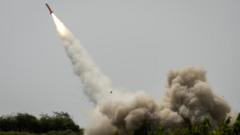European countries are pledging significant investments in their military industries as they grapple with the challenges posed by dependency on American defense technology and the ongoing threat from Russia.
Europe’s Defense Quandary: Balancing Domestic Production and American Dependence

Europe’s Defense Quandary: Balancing Domestic Production and American Dependence
European nations are ramping up military spending, yet face challenges in delivering innovative defense technology amid reliance on U.S. manufacturers.
European nations have agreed to nearly double their military spending over the next decade, totaling around 14 trillion euros, or $16 trillion, in an effort to boost their domestic defense industries. However, it remains uncertain whether this funding will lead to substantial advancements in military innovation within Europe. This predicament is primarily attributed to what analysts have termed the "F-35 problem."
The continent finds itself lacking viable alternatives to critical defense equipment, particularly aircraft like Lockheed Martin's F-35 stealth fighter, which boasts features unmatched by European counterparts. Key components such as Patriot missile-defense systems, advanced drones, satellite-guided artillery, and essential command and control systems are predominantly sourced from the U.S., which complicates European nations' ambitions for self-sufficiency in defense production.
Compounding this challenge is the fact that many European countries have historically relied on American military hardware. As they consider new purchases, compatibility with existing American systems becomes a priority. This has heightened the debate among European leaders about whether to invest in their domestic defense capabilities or continue to procure America's cutting-edge technology, especially in light of the ongoing war in Ukraine and the perceived threat from a militarized Russia.
As Europe faces these pressing questions, the pathway to a robust, independent military industry may be fraught with obstacles and uncertainties. This situation underscores the broader implications of defense spending, national security, and international relationships in a rapidly evolving geopolitical landscape.




















